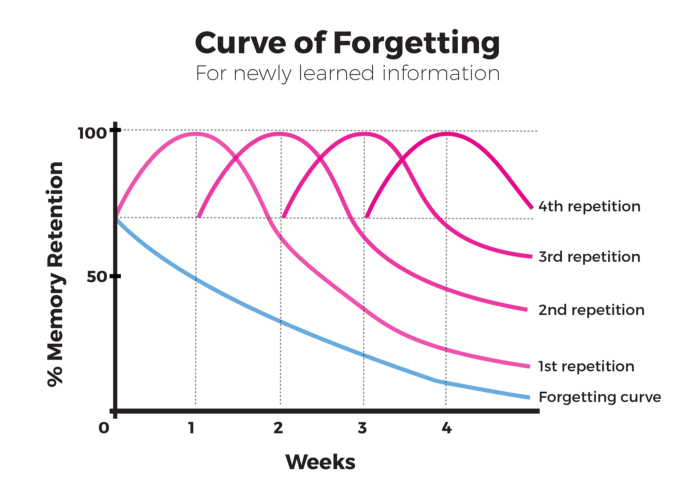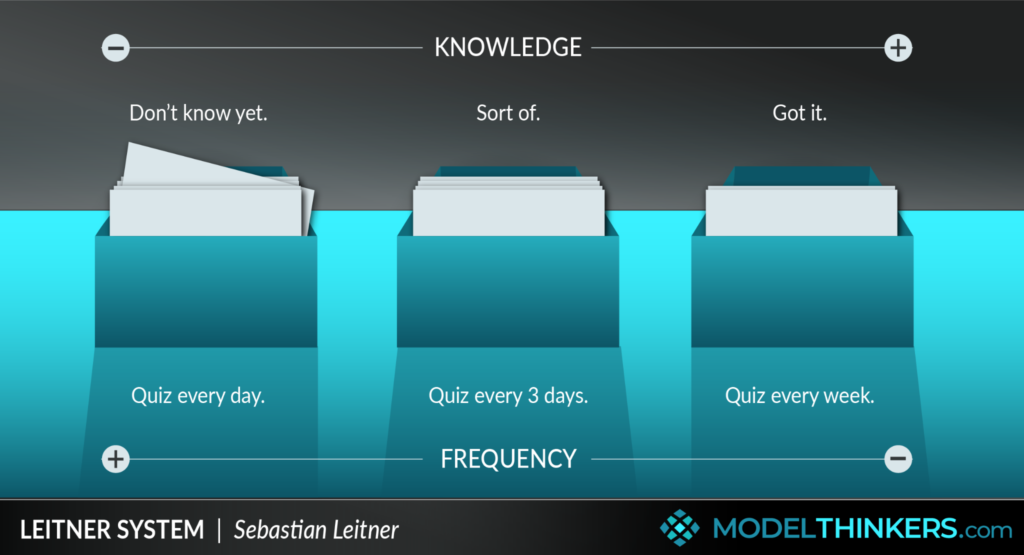Every student knows the pain of forgetting important concepts on the night before an exam. While studying hard is important, learning how to study smart is just as crucial. This week, we cover 4 techniques to use in your revision to help remember information longer and better!
Combating the Forgetting Curve
Why do we easily forget what we have studied? This is explained by a concept called the forgetting curve. It shows how easily we can forget something we’ve learnt when we don’t try to retain it.

As you can see in the graph, newly learned information tends to be lost in the first couple of days. After that, the rest of the information slowly fades overtime.
How can you combat the forgetting curve? Some effective techniques that can be used together are:
- Spaced learning
- Retrieval practice
- Leitner system
Spaced repetition/learning
Spaced repetition, also known as spaced learning, is the act of spacing out your revision time over shorter periods. After each revision period, you test yourself on what you’ve just learnt. Then, you revisit and review the information later in the day, the next day, or the week after.
In this way, you are actively making yourself recall the information from memory. Over many sessions, you tend to remember information more readily and find yourself remembering more of it. This significantly improves long-term retention of the information over time.
How to use this method?
- Break up your study material into smaller chunks, such as by chapters or by a number of key concepts.
- Spend the revision section trying to understand it and remember it as much as you can.
- Afterwards, take a short break and test yourself on the material.
- Over the next few days, review and revisit the information – after 1 day, after 3 days, after 1 week, etc. until you can recall it well.
Retrieval practice
Retrieval practice relies on putting what you’ve learnt into practice, through testing yourself via quizzes or practice papers. Instead of simply reading through the content, you force your brain to retrieve the information and apply it. In this way, the likelihood of remembering what you’ve learned is greatly increased. It also allows you to be aware of topics that you have not grasped fully.
The retrieval practice works best together with the spaced learning technique.
How to use this method?
- Attempt practice questions related to the topic, by using quizzes, flash cards, practice papers, etc.
- Use a cover-and-check method, where you cover up the content, attempt to recall, and then uncover to check
- Leitner system (covered in detail below)
- Feynman technique (covered in detail below)
Leitner system
The Leitner system combines the strength of the above studying techniques, to greatly enhance long-term retention of information.

How to use this method?
- Prepare 3 boxes and place all of your flash cards (one concept per flash card) into the first box. For this example, the boxes can be labeled:
Box 1: Every day
Box 2: Every other day
Box 3: Once a week
- Box 1 is what you’ll be reviewing daily. All newly created cards enter this box, together with any cards that were answered incorrectly from box 2. This box is to help you review any difficult facts and concepts that were tough to recall at first.
- Box 2 is where you’ll be promoting any flash cards you were able to answer correctly from box 1. The idea behind this is to tell yourself that you remember these concepts and no longer need to review them daily.
- Box 3 is the box you’ll be opening least frequently, with reviewing taking place only once per week. This is because it contains concepts that you have already been mastered.
Feynman Technique

Essentially, the Feynman technique is a self-directed learning method. It allows you to assess yourself as to whether you understand a topic deeply enough, and helps you to pinpoint specific problem areas that need improvement.
How to use this method?
- Choose a concept you want to learn about.
- Assess your understanding by writing down an explanation of the idea in the simplest way possible, as if you were teaching it to someone who does not understand it at all.
- If you can’t explain it fully, relearn the content until you feel more confident in your explanation.
- Only when you can explain the subject in simple terms do you understand it.
Last few pointers on revising effectively
Learning new content can be intimidating, but by learning how to study smart with these methods, you are sure to grasp any new concepts with time! These techniques also work well together to help you revise more effectively and quickly.
The key is finding the spacing period that works best for you, your topic, and your ability to recall information over time. Remember to give yourself ample breaks so you can space out your revision across multiple subjects too.
On top of incorporating these methods to your revision process, be sure to check out our online shop to view our guidebooks and assessment books from pre-school to JC level, educational magazines, children’s books, digital flashcards and more!
